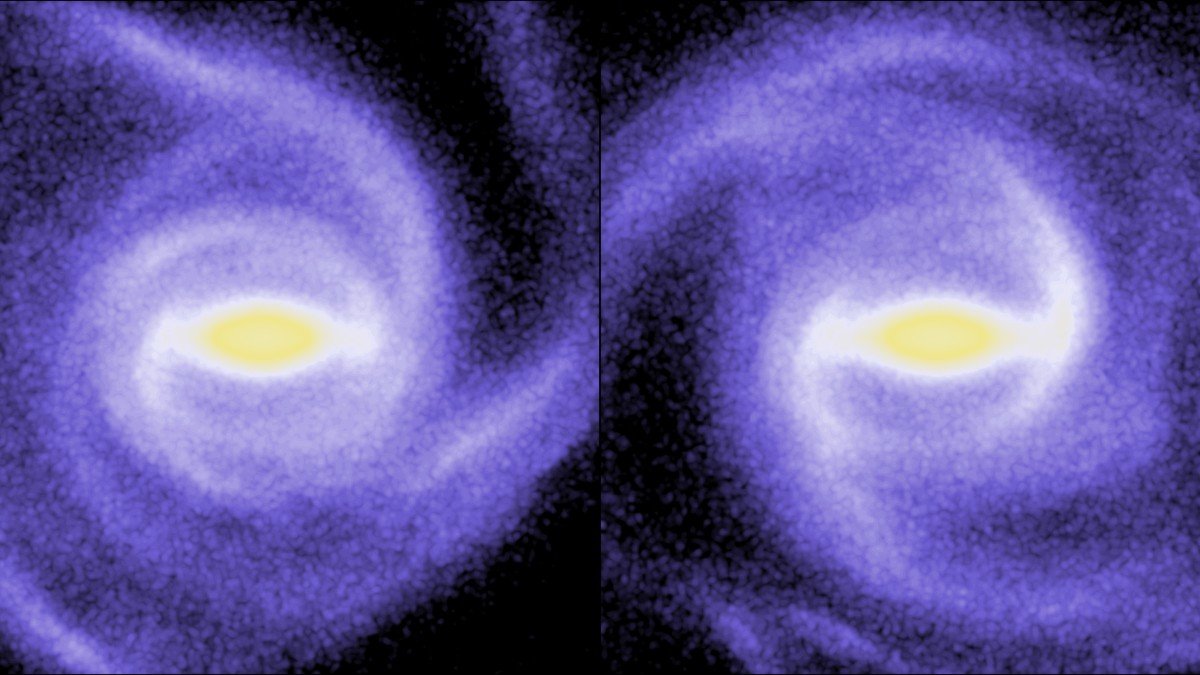Surrey PhD student resolves galactic bar paradox through cosmic dance theory
New light has been shed on a mysterious and long-standing conundrum at the very heart of our galaxy. The new work offers a potential solution to the so-called ‘Galactic bar paradox’, whereby different observations produce contradictory estimates of the motion of the central regions of the Milky Way. The results are published in Monthly Notices of the Royal Astronomical Society.

Image caption: When the bar (horizontal in yellow and white) is in its shorter phase on the left, a few spiral arms can be seen near, but not quite firmly connected to the bar. Meanwhile, when the bar is at its longest on the right, there are two stronger spiral arms passing through this time around. These are more clearly connected to either end of the bar, effectively dragging it out and slowing it down.
The majority of spiral galaxies, like our home the Milky Way, host a large bar-like structure of stars in their centre. Knowledge of the exact bar size and rotational speed is crucial for understanding how galaxies form and evolve, as well as how they create similar bars throughout the Universe.
However, our galaxy’s bar size and rotational speed have been strongly contested in the last five years. Studies of the motions of stars near the Sun find a bar that is both fast and small, direct observations of the Galactic Center region agree on one that is significantly slower and larger.
The new study, by an international team of scientists led by Tariq Hilmi, PhD student from the University of Surrey and Ivan Minchev of the Leibniz Institute for Astrophysics Potsdam (AIP), suggests an insightful solution to this discrepancy. Analysing state-of-the-art galaxy formation simulations of the Milky Way, they show that both the bar’s size and its rotational speed fluctuate rapidly in time, causing the bar to appear up to twice as long and rotate 20 per cent faster at certain times.
The bar pulsations result from its regular encounters with the Galactic spiral arms, in what can be described as a “cosmic dance”. As the bar and spiral approach each other, their mutual attraction due to gravity makes the bar slow down and the spiral speed up. Once connected, the two structures move as one, and the bar appears much longer and slower than it is. As the dancers split apart, the bar speeds up while the spiral slows back down.
Tariq Hilmi said: “Our research shows that the controversy surrounding the galactic bar can be resolved if we happen to be living at a time when the bar and spiral are connected, giving the illusion of a large and slow bar. However, the motion of the stars near the Sun remains governed by the bar’s true, much smaller nature, and so those observations appear contradictory.”
The bulk of this work was undertaken by Tariq as part of his Surrey Physics undergraduate research placement year at the AIP in Postdam.
Professor Justin Read, Head of Physics at the University of Surrey and a co-author on the study, said: “At Surrey, all of our undergraduate MPhys students go on a unique year-long placement in leading laboratories all over the world. It’s amazing to see how our students grow and develop during their placement to become professional researchers. This is a particularly outstanding example in which Tariq’s placement work has led to a solution to the long-standing Galactic bar paradox.”
Recent observations have confirmed that the inner Milky Way spiral arm is currently connected to the bar, which happens about once every 80 million years according to the simulations. Data from the forthcoming 3rd data release of the Gaia mission will be able to test this model further, and future missions will discover if this happens in other galaxies across the Universe.
Note to editors
The new work appears in, Fluctuations in galactic bar parameters due to bar-spiral interaction, T. Hilmi, I. Minchev, T. Buck, et al., Monthly Notices of the Royal Astronomical Society (2020), in press (DOI:https://doi.org/10.1093/mnras/staa1934).
Get a copy of the paper.
Featured Academics
Media Contacts
External Communications and PR team
Phone: +44 (0)1483 684380 / 688914 / 684378
Email: mediarelations@surrey.ac.uk
Out of hours: +44 (0)7773 479911

